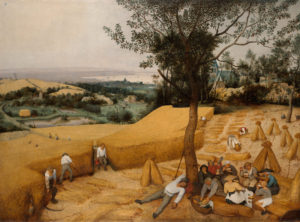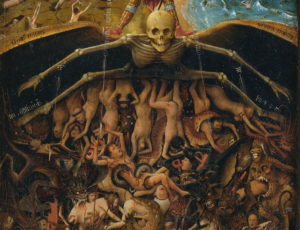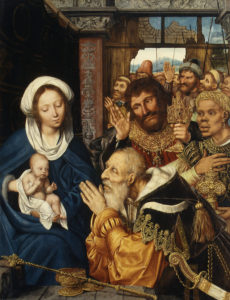So much is made of the Italian Renaissance that we tend to forget that it didn’t happen just there. In fact, as far as painting is concerned, one could almost say that the Renaissance happened first in cities far to the north, such as the Belgian cities of Bruges and Antwerp.
It was in the north that a genius named Jan van Eyck perfected oil painting as a medium and invented a style of realistic painting that was to influence the course of Western art for a good 500 years. During the first half of the 15th century the two most famous artists in the world were Van Eyck and Rogier van der Weyden. Their stunning microcosms of the visible world, often painted on small altarpieces, were studied and admired by such Italian artists as Fra Angelico, Botticelli, and Leonardo da Vinci.

“The Harvesters,” by Pieter Bruegel the Elder.
Of course, the Italians were ultimately to run away with the ball, but the pioneering work of the Netherlandish painters, spanning the years 1420 to 1560, is a glorious period in art with a character all its own, and this is the subject of “From Van Eyck to Bruegel: Early Netherlandish Painting in the Metropolitan Museum of Art,” which opens Tuesday. With works drawn almost entirely from the Met’s comprehensive holding, this is an opportunity to see paintings from the storerooms, as well as familiar pictures in new company.
Many of the pictures are small altarpieces, originally made for private devotions. They are either diptychs – two panels hinged together so that they could be folded and easily transported, or triptychs – large center panels with two hinged wings. Some pictures in the show are fragments of diptychs and triptychs that were dismantled for sale as individual works of art.
The northern artists were relentless in the pursuit of detail. Less was never more. When there’s a clump of weeds in the foreground, you can be sure that close inspection will show them to be botanically correct. We not only see the fly on the window sill, but the veins in the fly’s wings. Not for them was the Italian technique of sfumato, in which the edges of things disappeared into blurry shadow.
As devoted as they were to the natural world, the northern painters also exercised a fantastic imagination.
In Van Eyck’s “Last Judgment,” we come face to face with one of the most vivid renderings of Hell in the Western tradition. In that systematic way of the northern sensibility, Van Eyck set out to paint creation top to bottom.

Detail of Hell from Van Eyck’s “Last Judgment.”
As in Milton’s “Paradise Lost,” in which the character of Satan is the most interesting, it is Van Eyck’s Hell – not his heaven – that draws our attention. Heaven, with its symmetrical ordering of saints and the blessed, can’t help but look a bit dull, like a high school graduation. Down below is where the action is, as humans squirm like worms beneath the ground, devoured by monsters, squeezed by snakes, skewered by swords, and scorched by flames. In spirit, this is a medieval painting. The surface world, the world of society, is treated as nothing more than a place where desperate souls pop out of holes in the ground, trying to escape Hell.
In fact, the Netherlandish painters never seemed very comfortable with the Renaissance idea of putting man at the center of the universe. No matter the foreground drama, the painters in this show have a tendency – similar to that in Chinese painting – to lead us off into the distance, across successive hills and valleys, until the foreground event pales in comparison with the whole of creation.
“About suffering they were never wrong, the old masters,” said W.H. Auden in a poem inspired by Bruegel’s “Fall of Icarus,” in which a peasant plows his field and a ship sails by, everyone too busy to notice or care that a boy has just fallen from the sky.
In Joachim Patinir’s “Penitence of Saint Jerome,” the saint’s sufferings are nearly eclipsed by the great panoramic landscape that stretches across all three panels of this large altarpiece.
The northern artists also had a sense of humor. They didn’t shy away from folly and coarseness. In Quentin Massys’ “Adoration of the Magi,” the witnesses to the birth include a number of apparent hooligans, fools, and grotesques. In Pieter Bruegel the Elder’s great masterpiece, “The Harvesters,” the peasants dully work, sprawl out to nap, or push food into their gaping mouths. Bruegel was not one of those artists who romanticized simple people or manual labor.

“The Adoration of the Magi,” by Quentin Massys (1526).
The Netherlandish artists were less sentimental than their southern counterparts. These artists painted people, for the most part, as they were, not according to some idealized concept of beauty, goodness, or nobility, something the Italians were more prone to. Even when they sought to paint a beautiful woman, there is often something odd in the physiognomy, a too-high forehead, a long upper lip, eyes that diverge.
But, as a result, the subjects of these paintings seem like real people, with quirks and flaws and definite character. Not surprisingly, the Netherlanders excelled at portraiture. We see it in Petrus Christus’ “Portrait of a Carthusian,” which captures the strong faith of the youthful monk.
This is the kind of show that you go through slowly. In fact, it wouldn’t hurt to bring a magnifying glass for a few of the works. The pictures are rich in detail, incident, and symbolism, and they are always yielding up new secrets.

